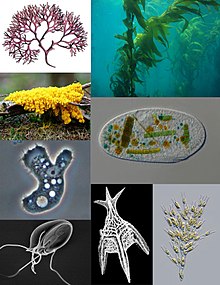Voromonas is a genus of predatory alveolates. The genus and species were described by Mylnikov in 2000.[1] It was originally described as Colpodella pontica but was later renamed by Cavalier-Smith and Chao in 2004.
https://en.wikipedia.org/wiki/Voromonas
The alveolates (meaning "with cavities")[2] are a group of protists, considered a major clade[3] and superphylum[4] within Eukarya, and are also called Alveolata.[5]
https://en.wikipedia.org/wiki/Alveolate
A protist (/ˈproʊtɪst/) is any eukaryotic organism (that is, an organism whose cellscontain a cell nucleus) that is not an animal, plant, or fungus. While it is likely that protists share a common ancestor (the last eukaryotic common ancestor),[2] the exclusion of other eukaryotes means that protists do not form a natural group, or clade.[a] Therefore, some protists may be more closely related to animals, plants, or fungi than they are to other protists; however, like algae, invertebrates, or protozoans, the grouping is used for convenience. The study of protists is termed protistology.[3]
The classification of a kingdom separate from animals and plants was first proposed by John Hogg in 1860 as the kingdom Protoctista; in 1866 Ernst Haeckel also proposed a third kingdom Protista as "the kingdom of primitive forms".[4] Originally these also included prokaryotes, but with time these would be removed to a fourth kingdom Monera.[b] In the popular five-kingdom scheme proposed by Robert Whittakerin 1969, Protista was defined as eukaryotic "organisms which are unicellular or unicellular-colonial and which form no tissues", and the fifth kingdom Fungi was established.[5][6][c] In the five-kingdom system of Lynn Margulis, the term protist is reserved for microscopic organisms, while the more inclusive kingdom Protoctista (or protoctists) included certain large multicellular eukaryotes, such as kelp, red algaeand slime molds.[9] Others use the term protist interchangeably with Margulis's protoctist, to encompass both single-celled and multicellular eukaryotes, including those that form specialized tissues but do not fit into any of the other traditional kingdoms.[10]
Besides their relatively simple levels of organization, protists do not necessarily have much in common.[11] When used, the term "protists" is now considered to mean a paraphyletic assemblage of similar-appearing but diverse taxa (biological groups); these taxa do not have an exclusive common ancestor beyond being composed of eukaryotes, and have different life cycles, trophic levels, modes of locomotion and cellular structures.[12][13] Examples of protists include:[14] amoebas (including nucleariids and Foraminifera); choanaflagellates; ciliates; diatoms; dinoflagellates; Giardia; Plasmodium (which causes malaria); oomycetes (including Phytophthora, the proximate cause of the Great Famine of Ireland); and slime molds. These examples are unicellular, although oomycetes can form filaments, and slime molds can aggregate.
In cladistic systems (classifications based on common ancestry), there are no equivalents to the taxa Protista or Protoctista, as both terms refer to a paraphyletic group that spans the entire eukaryotic tree of life. In cladistic classification, the contents of Protista are mostly distributed among various supergroups: examples include the SAR supergroup (of stramenopiles or heterokonts, alveolates, and Rhizaria); Archaeplastida (or Plantae sensu lato); Excavata (which is mostly unicellular flagellates); and Opisthokonta (which commonly includes unicellular flagellates, but also animals and fungi). "Protista", "Protoctista", and "Protozoa" are therefore considered obsolete. However, the term "protist" continues to be used informally as a catch-all term for eukayotic organisms that are not within other traditional kingdoms. For example, the word "protist pathogen" may be used to denote any disease-causing organism that is not plant, animal, fungal, prokaryotic, viral, or subviral.[15]
| Protist Temporal range: Paleoproterozoic[a] – Present | |
|---|---|
 | |
| Scientific classification | |
| Domain: | Eukaryota |
| Groups included | |
Supergroups[1] and typical phyla
Many others; | |
| Cladistically included but traditionally excluded taxa | |
https://en.wikipedia.org/wiki/Protist
No comments:
Post a Comment